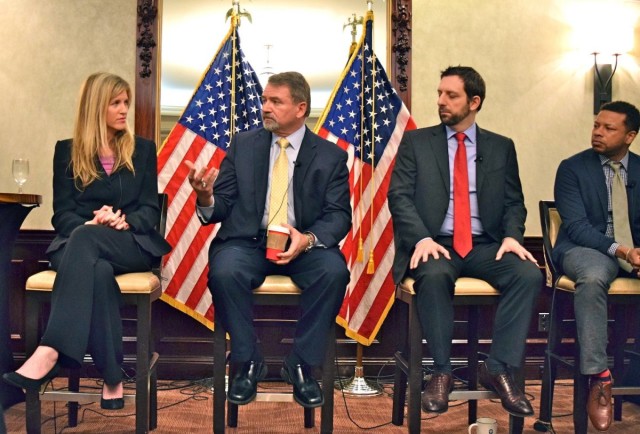The Federal Aviation Administration and NASA are discussing a joint approach to introducing small drones into the airspace that could give the space agency a larger role in the effort. NASA’s Ames Research Center is already leading the development of an Unmanned Aerial System Traffic Management, or UTM, system that would manage low-flying drones.
The current discussions could lead to even broader participation by the space agency, said the FAA’s lead executive for unmanned aircraft systems (UAS).
“We’re currently in deliberations,” confirmed Marke “Hoot” Gibson, FAA senior advisor for UAS integration. “We have a great relationship with NASA; they do a lot of the fundamental science and research on a number of topics in aerospace—this being one of them.” What the two agencies are considering is “should we broaden that relationship, not just the UTM focus,” he added. “It would be something that focuses our energies and collaboration on UAS, and it’s not clear yet what that will look like.”
Gibson spoke on November 12 at a policy briefing hosted by law firm Hogan Lovells in Washington, D.C.The former Air Force major general, who was named to the FAA post in September, said he planned to discuss the evolving arrangement the following week with Parimal Kopardekar, a NASA principal investigator and former FAA engineer who leads the UTM development at NASA Ames Research Center in Mountain View, Calif.
In September, AIN reported that the FAA and NASA planned to form a committee that would meet under the auspices of standards organization RTCA to set standards for the commercial use of small drones. At the Air Traffic Control Association (ATCA) conference earlier this month, speakers said they eagerly awaited the outcome of those deliberations. NASA, which has a pool of research and development money to draw from, is expected to emerge with a leading role. The FAA, meanwhile, is hard pressed to accomplish its “NextGen” modernization of the ATC system and faces being restructured by Congress in coming reauthorization legislation.
“NextGen is not currently poised to handle the UAS conundrum,” Mel Davis, NextGen representative for the National Air Traffic Controllers Association, told reporters at the ATCA conference. “You see this tension between NASA and the FAA right now” over managing the entry of drones into the airspace, he added. “Who drives that from a federal government perspective? Will it be NASA or will it be the FAA? My intuition is that it will be NASA.”
Ali Bahrami, Aerospace Industries Association vice president for civil aviation and a former high-rankingFAA executive, concurred that NASA will become more prominent on drones. He cited the space agency’s close association with Internet giants Amazon and Google, which both plan to deliver small packages by drone. Amazon Prime Air co-founder Gur Kimchi gave the keynote address at the NASA Ames UTMconference in July. Google has a Space Act Agreement with NASA Ames to collaborate on “autonomous vehicle operations concepts and technologies.” Its corporate headquarters are in Mountain View.
“NASA is going to take it because they have the technology right now with the support from Google and Amazon to make it happen,” Bahrami said. “But at the end of the day it’s going to come down to who’s got jurisdiction over the airspace and who is going to manage it. It could be a situation where it lends itself to some kind of a public-private corporation to (manage the airspace) below 500 feet for small UASs. It’s still wide open, frankly.”
Google has convened invitation-only seminars for industry and government participants in California and Washington, D.C., to promote its vision of drone deliveries, which includes the concept of an “airspace service provider” that would manage lower-altitude airspace in place of the FAA.
Following a keynote speech he gave at the ATCA conference, Dave Vos, who leads Google’s Project Wing effort, said the company appreciates the NASA-led UTM program. “It’s a great, public non-partisan, non-biased, non-favored environment where anyone can play and everyone gets to contribute ideas,” he said. “It’s really good for us. We love the idea that there is this public entity that can be unbiased.”
Photo: From left, Lisa Ellman of Hogan Lovells, Marke Gibson of the FAA, John Verdi of the National Telecommunications and Information Administration and Travis Mason of Google address UAS policy briefing in Washington, D.C. – Bill Carey
Source: AIN Online

